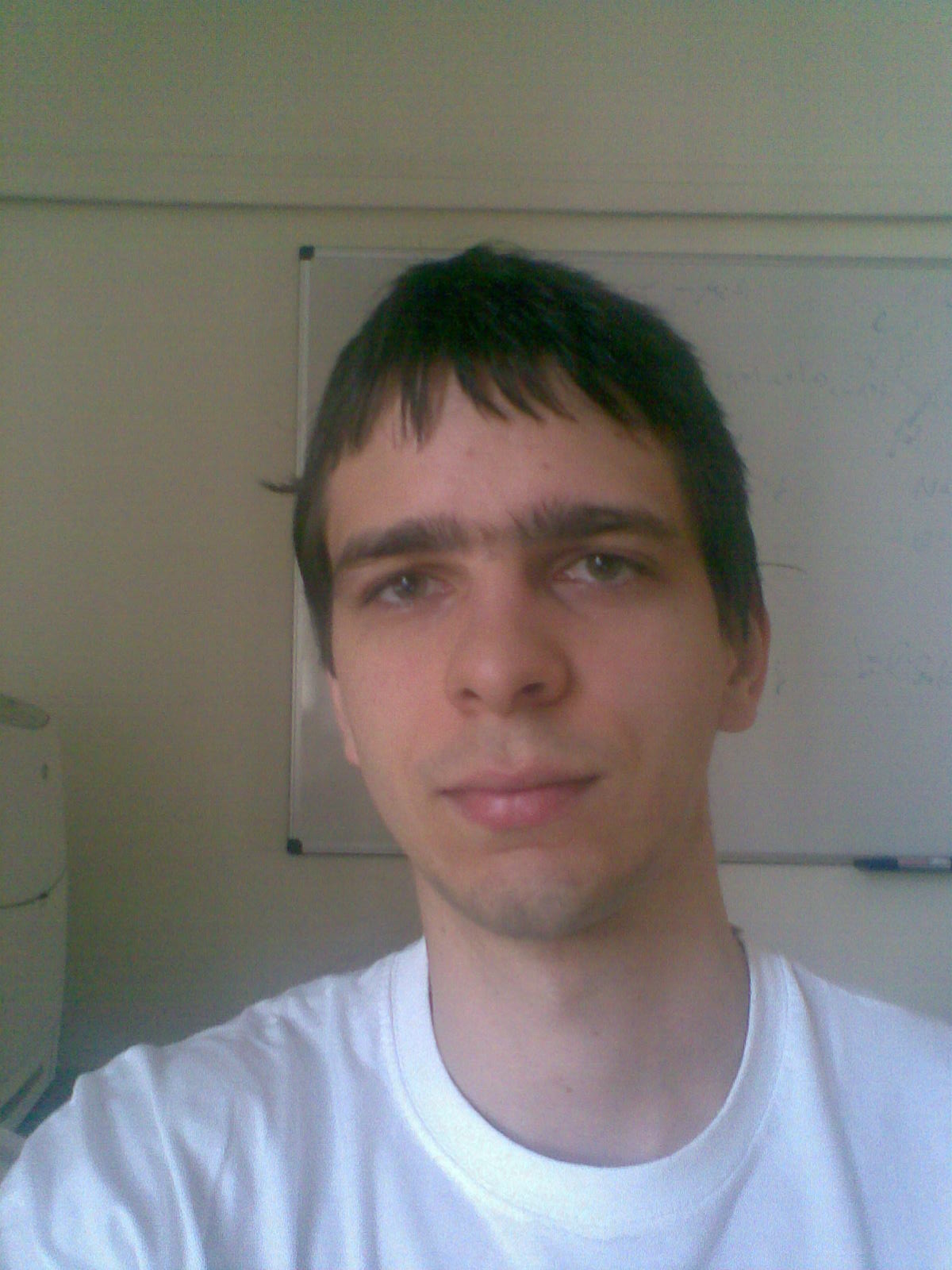 |
BMe Research Grant |

|
Doctoral School of Physical Sciences
Department of Nuclear Techniques/Institute of Nuclear Techniques
Supervisors: Dr. Sándor Fehér, Dr. Gyula Csom and Dr. Szabolcs Czifrus
Analysis of Supercritical Water Cooled Reactors
Introducing the research area
During my PhD studies, I worked on the neutronics
and thermal hydraulics aspects of Supercritical Water Cooled Reactors (SCWRs). I
was greatly supported by my supervisors. The first part of our research included
the analysis of Xenon oscillations in these reactors. At this time, we are
searching for SCWR assembly configurations capable of breeding the
fissile material while maintaining a positive reactivity.
Brief introduction of the research place
The Department of Nuclear
Techniques (NTI) has made itself a name internationally through its
high-standard education and research activities. Its main research fields
include reactor physics, thermal hydraulics, radiation protection and fusion. In
the reactor physics research group, among others, we carry out calculations for
the reactors of the Paks Nuclear Power Plant and
analyze generation IV nuclear
reactor concepts.
History and context of the research
The Generation
IV International Forum is the most significant scientific program dealing with
the future of nuclear energy. After a thorough selection process, where major
criteria included sustainability, safety and reliability, proliferation resistance
(minimizing the risk of diversion or theft of weapons-usable materials) and
physical protection, the forum chose six reactor concepts for further R&D [1]. These are: Gas Cooled Fast Reactor (GFR, [2]), Lead Cooled Fast Reactor (LFR, [3]), Sodium Cooled Fast Reactor (SFR, [4]), Molten Salt Reactor (MSR, [5]), Supercritical Water Cooled Reactor (SCWR, [6]) and Very High Temperature Reactor (VHTR, [7]).
SCWR is a high-temperature, high-pressure light water cooled reactor operating above the critical point of water (374°C, 221 bar). It combines the advantages of today's Light Water Reactors and supercritical pressure fossil fired power plants (e.g. higher plant efficiency, lower coolant inventory, no boiling crisis). Based on the setup of the core, it can have a fast or a thermal neutron spectrum. SCWRs were already investigated in the 1950s and '60s, and they again became the focus of attention in the '90s when new Japanese [8] and Russian [9] concepts were developed. The results encouraged other nations as well: the Americans [10] and Koreans [11] launched their SCWR-projects, the development of the Canadian CANDU to supercritical pressures is evidence [12], a European consortium designed the High Performance Light Water Reactor (HPLWR, [6]). The NTI joined the international HPLWR Phase 2 project which started in 2006.
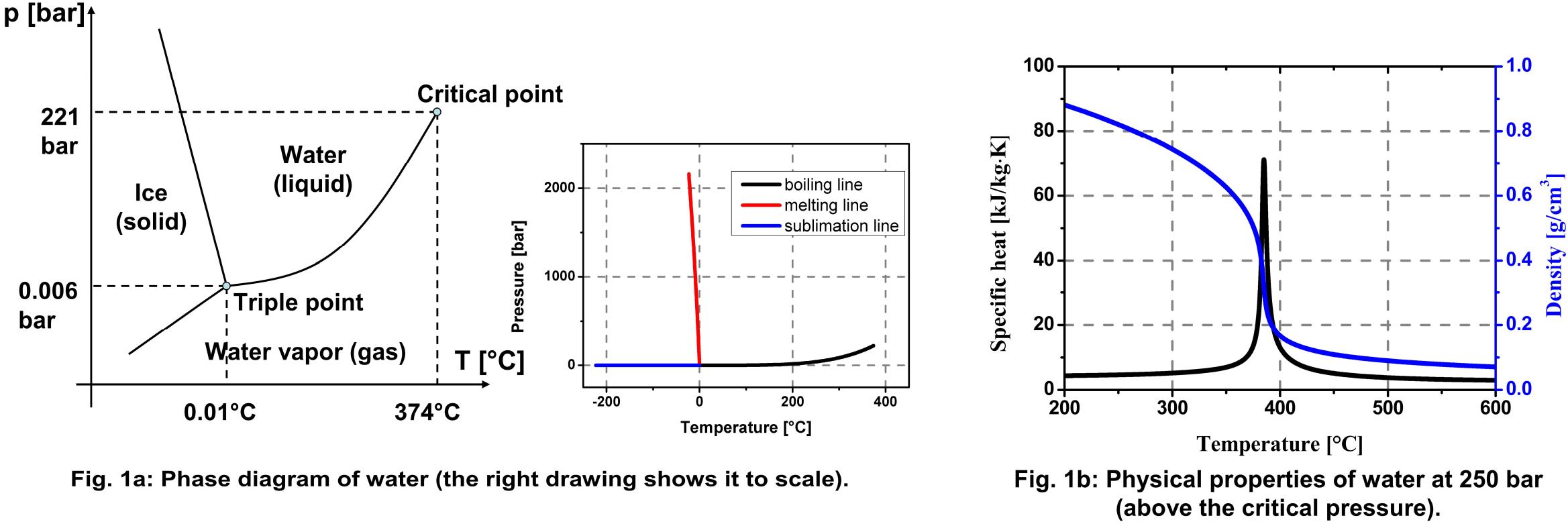
The research goal, open questions
In a typical SCWR the coolant, supercritical
pressure water, 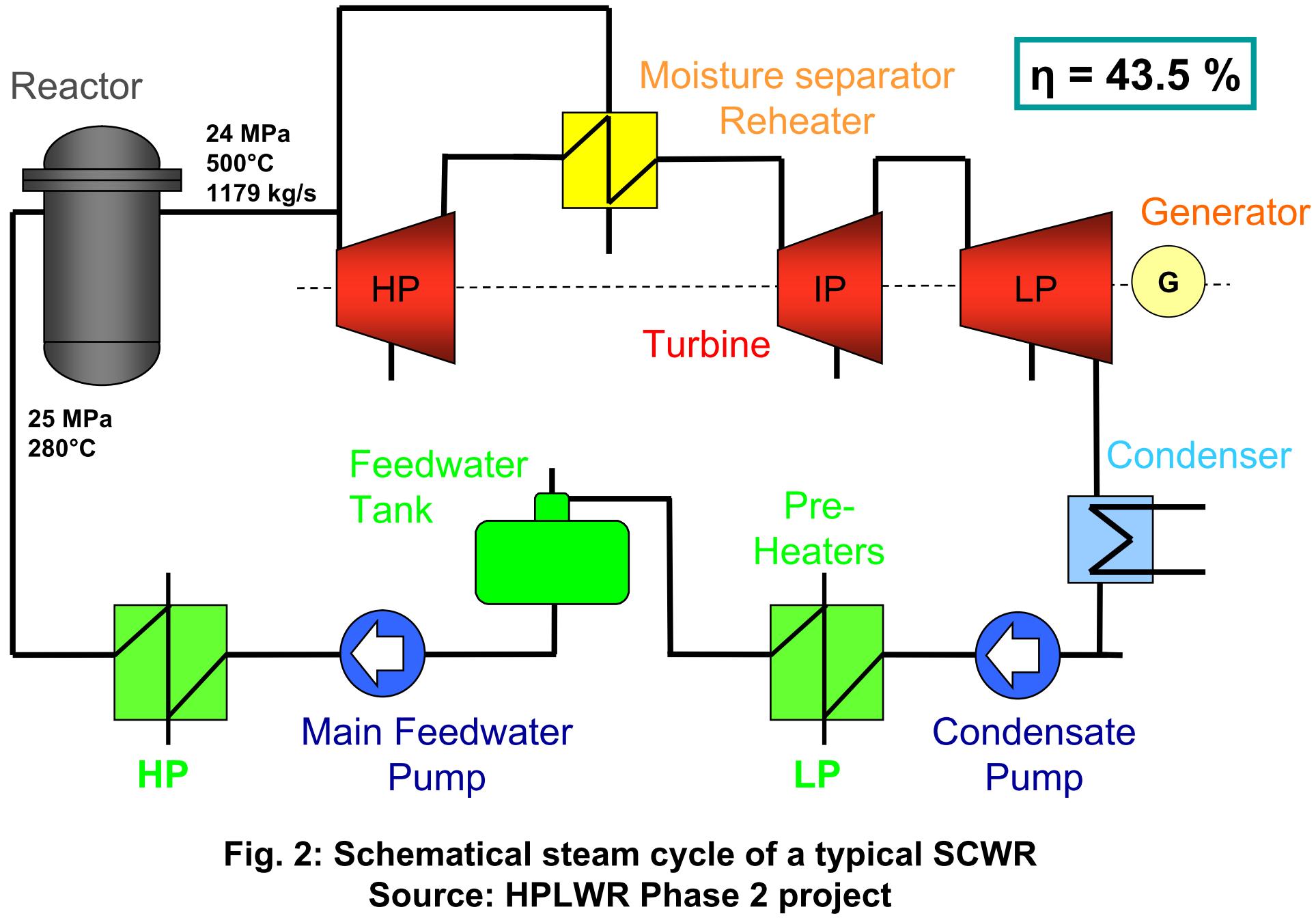 has two unctions
in the core: cooling of the fuel assemblies and slowing down (moderation) of the
neutrons. While passing through the core, during a heat-up of about 220°C (from
280°C to 500°C), the density of water changes approximately by an order of
magnitude (although without phase transition). This means that the system
exhibits a propensity to local temperature, density and power oscillations. These phenomena are
increased by the pseudocritical transition – a dramatic, but continuous change
in the physical properties between 372 and 392°C – of the water.
has two unctions
in the core: cooling of the fuel assemblies and slowing down (moderation) of the
neutrons. While passing through the core, during a heat-up of about 220°C (from
280°C to 500°C), the density of water changes approximately by an order of
magnitude (although without phase transition). This means that the system
exhibits a propensity to local temperature, density and power oscillations. These phenomena are
increased by the pseudocritical transition – a dramatic, but continuous change
in the physical properties between 372 and 392°C – of the water.
In order to mitigate the consequences from the large density (and moderation) decrease of the coolant, several solutions have been proposed, e.g. in the HPWLR water rods (moderator boxes) are placed in the middle of the fuel assemblies, and the core has a three-pass coolant flow path [6]. On the other hand, these solutions made the design of SCWR concepts quite complicated. With simplicity in mind, we set the goal to design a SCWR assembly which has a simple coolant flow path and additionally has a much better fuel utilization than the present concepts.
Most of the SCWR designs feature a core with an
active height greater than 4 meters, thus they are susceptible to spatial Xenon
oscillations caused by the strong neutron poison
135Xe. This effect, combined with the density and power oscillations
mentioned above, can lead to dynamic processes significantly
different from those observed in today's reactors. Thus, our second goal was to explore and
analyze these phenomena.
Methodology
The consider susceptibility to density and power
oscillations, using a coupled neutronics - thermal hydraulics
software is required. Our first goal was developing a program (see Fig.
3.) capable 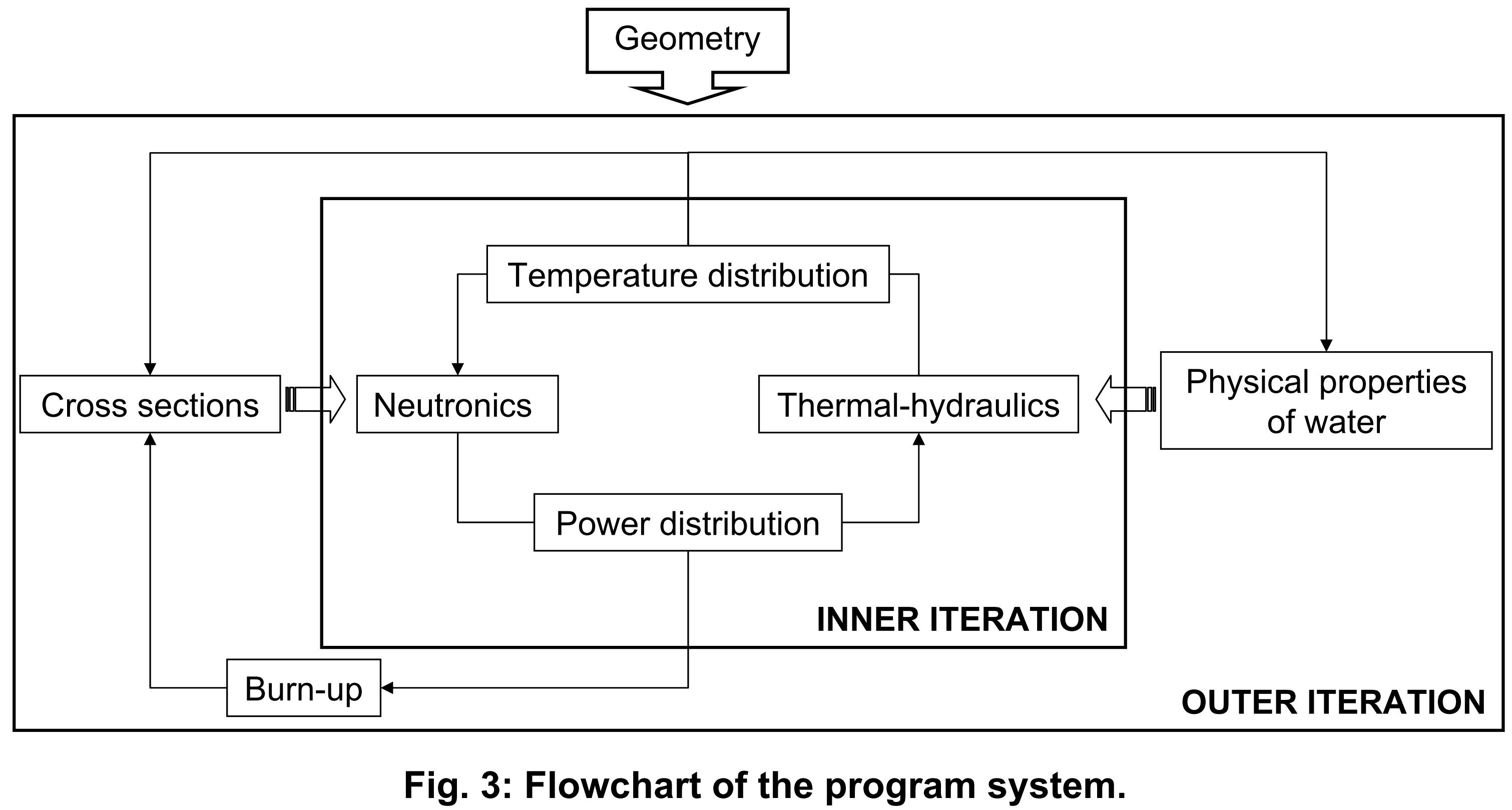 of determining
the stationary state (temperature and power distribution) of any SCWR, including the execution of
burnup
calculations. The power distribution determined in the inner iteration is used
in the subsequent burnup calculation. This idea is based on the observation that the
residence time of the coolant in the core is much smaller than the burnup time
step.
of determining
the stationary state (temperature and power distribution) of any SCWR, including the execution of
burnup
calculations. The power distribution determined in the inner iteration is used
in the subsequent burnup calculation. This idea is based on the observation that the
residence time of the coolant in the core is much smaller than the burnup time
step.
A typical discretization scheme used in the program system is shown in Fig. 4: on the left, you can see a vertically oriented assembly with the calculation points for the temperature, and the unit cell of calculation (only one fuel pin for better visibility) is shown to the right.
The inner iteration is responsible for the convergence of the temperature distribution. Due to the pseudocritical transition (the temperature dependence of density and the specific heat, in the first place, Fig. 1b) this is not trivial, thus we used under relaxation. Accuracy of the computational model can be improved if the reactivity feedback of the fuel temperature (Doppler effect) is also taken into account. Therefore, we also built a module into the program comprising the corresponding heat conduction and heat transfer differential equations.
In the outer iteration, the Bateman equations are solved for a given time step, which changes the material composition of the system. This results in the change of the microscopic cross sections, and consequently, the power distribution. Hence, a new steady-state solution has to be determined. The process is repeated until the desired burnup of the fuel is achieved.
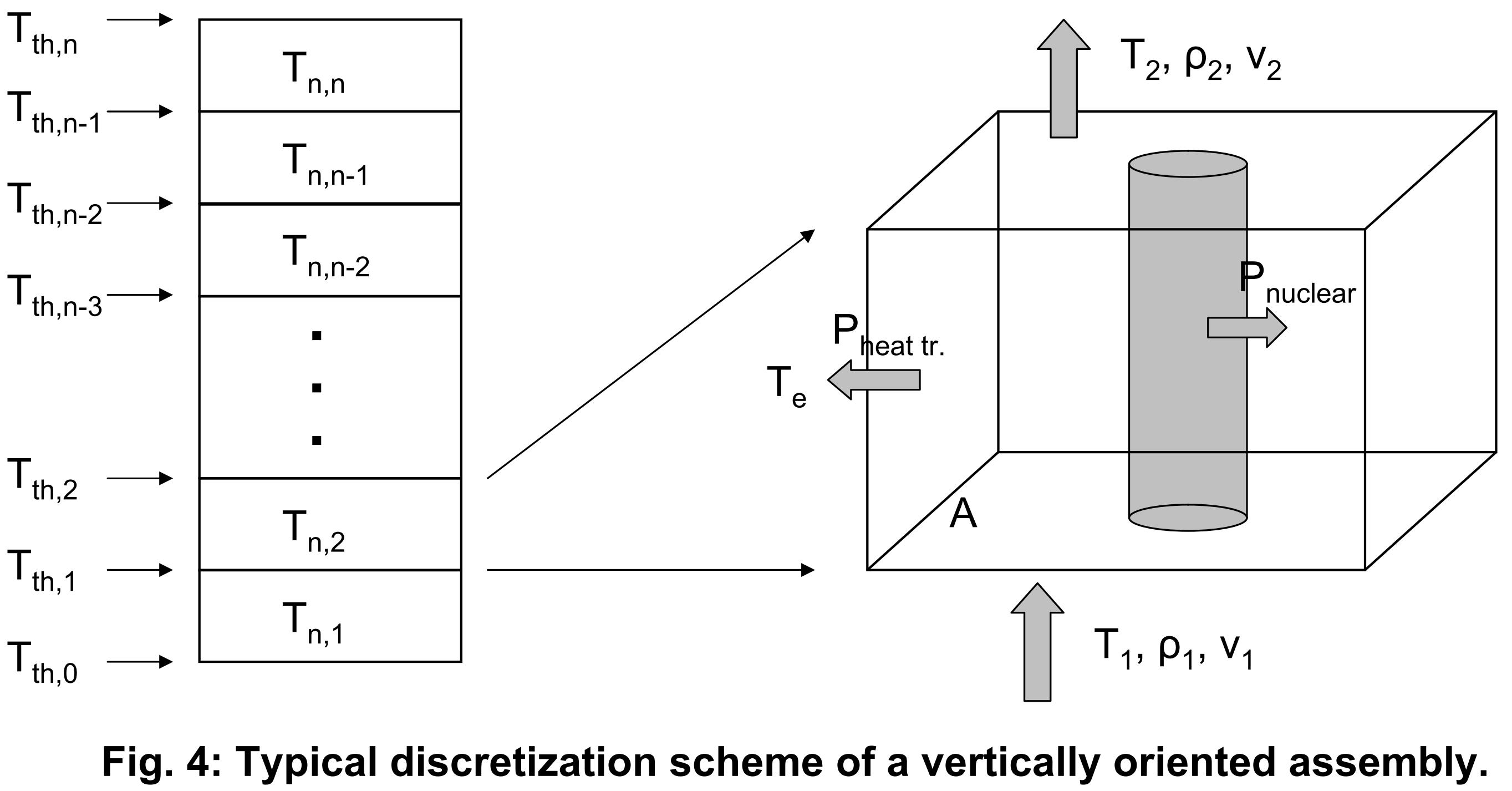
We placed great emphasis on modularity, which
allowed us to solve several different problems fast and efficiently. Inside
the neutronics module, we used the MCNP for the detailed three-dimensional
calculations, whereas for larger models (e.g. full core) we utilized the SCALE code package. Based on judicious, reasonable and validated methods, we developed a
cross section homogenization process for
the code package, to simplify the examined system
in multiple steps. This significantly reduced the required computational time.
Additionally, we implemented the differential equations for the calculation of
Xenon oscillations into the program.
Results
To verify the proper operation of the program, we carried out several comparative calculations, e.g. for the three-pass HPLWR. [A, B, C]
SCWR assembly with ZrH extra moderator
To avoid a complicated coolant flow path, caused by the "moderator box" in HPLWRs, we examined assembly configurations which use zirconium-hydride rods as extra moderator. To compensate the axial density drop of coolant and the accompanying decrease in the moderation, we have gradually replaced several of the fuel pins with these ZrH rods. We determined the optimal configuration of a fresh core consisting of the above assemblies while minimizing the radial and axial power peaking. However, the above simplification could only be done at the expense of an increase in the average enrichment of fuel. This questions the economics (competitiveness) of this concept, so we looked for other solutions. [D, E]
SCWR assembly with Thorium-based fuel
We recognized that the main reason for the
unfavourable properties was the usage of uranium 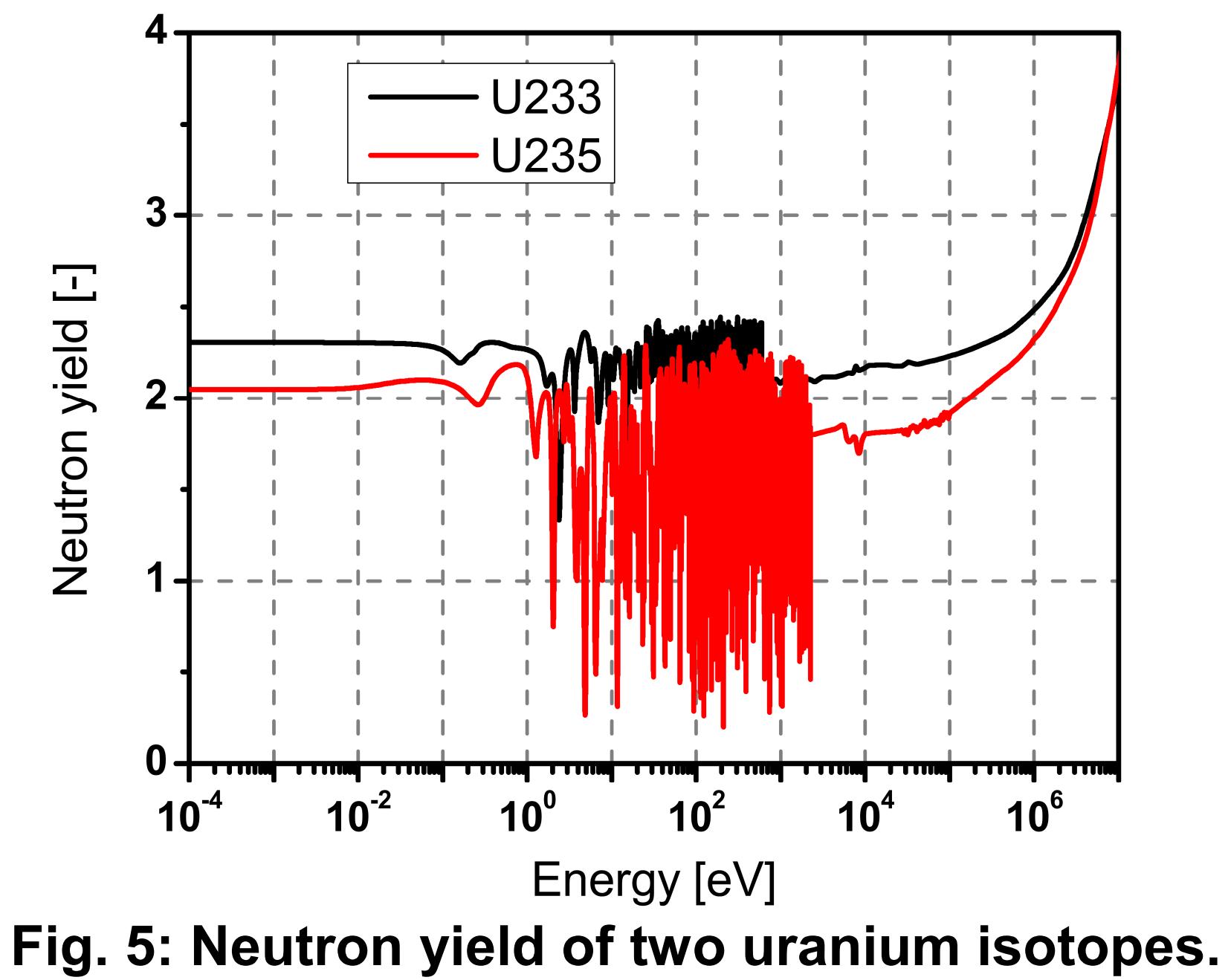 dioxide, which is the conventional fuel in today's nuclear power
plants. In this fuel the 235U isotope is the fissile material (the
238U isotope is only fissionable by fast neutrons, although fissile
isotopes, e.g. plutonium-239, can form through neutron capture and successive
beta decays). 233U is also a fissile isotope, but due to its short
half-life it can only be found in traces in natural Uranium. In reactors, however, it can be
produced from Thorium-232 through neutron
capture and two successive beta decays. The 233U is superior to the
235U with respect to neutronics properties (e.g. neutron yield, see
Fig. 5), furthermore, due to the favourable energy dependence of the cross
sections there is no need for an extra moderator. Having verified these findings with
simple one-dimensional calculations, we started designing a SCWR
assembly with (Th-233U)O2 as fuel.
dioxide, which is the conventional fuel in today's nuclear power
plants. In this fuel the 235U isotope is the fissile material (the
238U isotope is only fissionable by fast neutrons, although fissile
isotopes, e.g. plutonium-239, can form through neutron capture and successive
beta decays). 233U is also a fissile isotope, but due to its short
half-life it can only be found in traces in natural Uranium. In reactors, however, it can be
produced from Thorium-232 through neutron
capture and two successive beta decays. The 233U is superior to the
235U with respect to neutronics properties (e.g. neutron yield, see
Fig. 5), furthermore, due to the favourable energy dependence of the cross
sections there is no need for an extra moderator. Having verified these findings with
simple one-dimensional calculations, we started designing a SCWR
assembly with (Th-233U)O2 as fuel.
The initial one-dimensional calculations were followed by two- and three-dimensional analyses, which resulted in the design of a two-pass assembly consisting of two regions with different fuel pin diameters and pitches. During the recently finished three-dimensional, assembly-wise, coupled neutronics - thermal hydraulics calculations we optimized the enrichment of the fuel pins and the burnable poison content. The final design is self-sustaining up to the burnup of 40.0 MWday/kg considering the fissile material. This means that after providing the initial fissile load, only the Thorium, which is 3-4 times more abundant on Earth than Uranium, has to be supplemented during the lifetime of the reactor. [G]
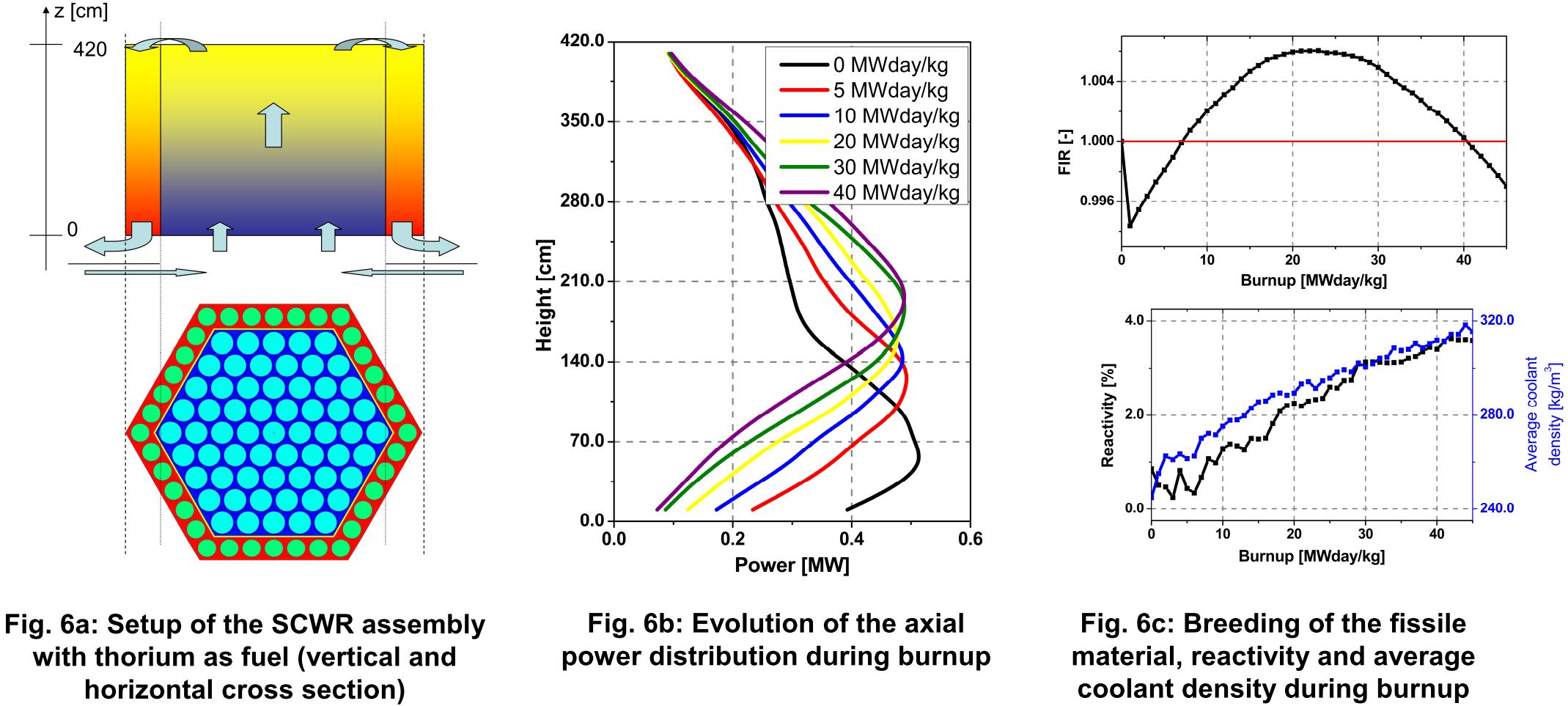
Xenon oscillation in SCWRs
By determining the approximate migration length
of the neutrons we found  that
the SCWRs are stable in a first order against Xenon oscillations. We demonstrated through detailed
three-dimensional calculations that it is the negative reactivity
feedback of the fuel temperature (Doppler effect) that is the dominant factor in the
stabilization of the reactor (Fig. 7). On the other hand, the large density
change of the coolant plays only a secondary role. We showed that reactors with
Thorium-based fuel assemblies also have an edge in this respect, over the UO2
versions due to the more favourable yield ratio of
fission products. [F]
that
the SCWRs are stable in a first order against Xenon oscillations. We demonstrated through detailed
three-dimensional calculations that it is the negative reactivity
feedback of the fuel temperature (Doppler effect) that is the dominant factor in the
stabilization of the reactor (Fig. 7). On the other hand, the large density
change of the coolant plays only a secondary role. We showed that reactors with
Thorium-based fuel assemblies also have an edge in this respect, over the UO2
versions due to the more favourable yield ratio of
fission products. [F]
Expected impact and further research
The research and development of fourth
generation reactors and the utilization of Thorium are hot topics in the
scientific community. The design of a SCWR would be a major improvement in
several aspects over today's light water reactors, and the usage of
Thorium would extend the lifetime of nuclear resources [13].
Based on the literature and on our
experience, it seems that the usage of the conventional uranium dioxide fuel
requires innovative, yet complicated SCWR designs. On the other hand,
we showed that a SCWR with a simple coolant flow path and Thorium-based fuel can
be self-sustaining in terms of fissile content. We continue the analysis and
optimization work of this kind of reactor (e.g. with equilibrium core design).
Publications, references, links
Related own publications
[A] Reiss, T, Horváth, D.,
Czifrus, Sz., Fehér, S. (2007) Determining the axial power distribution in HPLWR reactors with coupled neutronics and thermohydraulics calculations (in Hungarian). Magyar Energetika 2007/5.
[B] Reiss
T., Fehér, S., Czifrus, Sz. (2008) Enhancing the program used for coupled neutronics and thermohydraulics calculations for HPLWRs (in Hungarian).
Nukleon I.
[C] Reiss, T, Fehér, S., Czifrus, Sz (2008) Coupled neutronics and thermohydraulics calculations with burn-up for HPLWRs. Progress in Nuclear Energy 50.
[D] Reiss, T, Csom, Gy., Fehér, S., Czifrus, Sz. (2010) The Simplified Supercritical Water-Cooled Reactor (SSCWR), a new SCWR design. Progress in Nuclear Energy 52.
[E] Reiss, T, Csom, Gy., Fehér, S., Czifrus, Sz. (2010) Full-core SSCWR calculations applying a fast computational method. Progress in Nuclear Energy 52.
[F] Reiss, T, Fehér, S.,
Czifrus, Sz. (2011) Xenon oscillation in SCWRs. Progress in Nuclear
Energy 53.
[G] Reiss, T, Csom, Gy., Fehér, S., Czifrus, Sz. (2011)
Thorium as an alternative fuel for SCWRs. Submitted to Annals of Nuclear
Energy
Links
Generation IV International Forum
International Atomic Energy Agency
Institute of Nuclear Techniques, BME
References
[1] GIF (2002) A
technology road map for Generation IV nuclear energy systems
GIF-002-00.
[2] Anzieu
P., Stainsby R., Mikityuk K. (2009) Gas-cooled fast reactor (GFR):
overview and perspectives Proceedings of GIF Symposium, Paris,
September 9-10, 2009.
[3] Cinotti L., Smith
C.F., Sekimoto H. (2011) Lead-cooled fast reactor (LFR): overview and
perspectives Proceedings of GIF Symposium, Paris, September 9-10, 2009.
[4] Konomura M., Ichiyima M. (2007) Design challenges for sodium cooled fast reactors Journal of Nuclear Materials 371.
[5] Mathieu L. et al.
(2006) The thorium molten salt reactor: Moving on from the MSBR
Progress in Nuclear Energy 48.
[6] Fischer K.,
Schulenberg T., Laurien E. (2009) Design of a supercritical water-cooled
reactor with a three-pass core arrangement Nuclear Engineering and Design 239.
[7] El-Genk M.S., Tournier J.-M. (2009) Performance analyses of VHTR plants with direct and indirect closed Brayton cycles and different working fluids Progress in Nuclear Energy 51.
[8] Oka Y., Koshizuka S., Yamasaki T. (1992) Direct cycle light water reactor operating at supercritical pressure Journal of Nuclear Science and Technology 29.
[9] Silin V.A., Voznesensky V.A., Afrov A.M. (1993) The Light Water Integral reactor with natural circulation of the coolant at supercritical pressure B-500 SKDI Nuclear Engineering and Design 144.
[10] MacDonald P. et al. (2004) Feasibility study of Supercritical Water Cooled Reactors for electric power production Final report, INEEL/EXT-04-02530.
[11] Bae Y.-Y. et al. (2007) Research activities on a Supercritical Pressure Water Reactor in Korea Nuclear Engineering and Technology 39.
[12] Torgerson D.F. et al. (2006) CANDU technology for Generation III+ and IV reactors Nuclear Engineering and Design 236.
[13] IAEA-TECDOC-1450
(2005) Thorium fuel cycle – Potential benefits and
challenges
